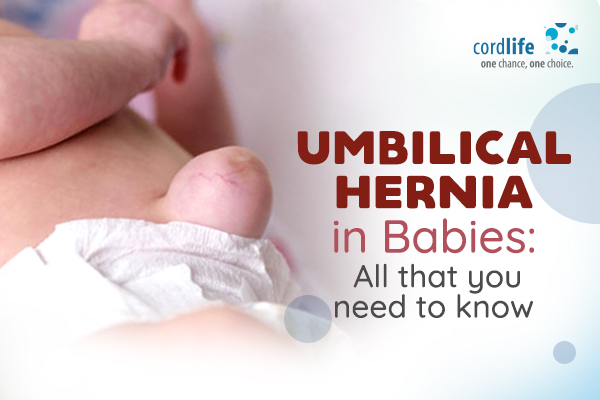Table of Contents
During pregnancy, it is the umbilical cord (along with the umbilical cord blood), that connects the mother to her baby and it plays the major role of delivering all the essential nutrients the baby needs for its growth before his or her birth. The cord grows with the baby, till such time that the baby is delivered.
Cutting of the cord takes place a few minutes later, after the baby is born. After the cord cutting, the part outside the cord is expected to fall off on its own. The skin is also expected to heal on its own and become the umbilicus. This umbilicus is also called the belly button.
Usually, the muscle around the umbilicus closes up soon after childbirth. However, in 1 in 5 new-born, this muscle around the belly button doesn’t close soon after birth. In fact, this gap or opening in the baby’s abdominal wall near the belly button or navel is known as the umbilical hernia in babies. The umbilical hernia causes part of the intestine to have a hernia sac, mostly covered by skin. If any fluid pokes through it, there is a bulge and swelling in the belly.
How Will You Know If Your Child Has Umbilical Hernia?
Umbilical hernia in new-born baby can be the most visible when a child cries, coughs or tries to strain while pooping. The reason behind this is, it exerts pressure on the baby’s stomach. However, the doctor might be able to say if the little one has hernia, when umbilical hernia baby symptoms like:
- pain around the bellybutton area,
- bulging of the belly button (one of the most common signs),
- discoloration of the bellybutton area as well as
- if vomiting is seen in the little one
With these symptoms in place, the baby is immediately taken to the emergency room, where the doctor takes a look at the area and feels it by touching it to deal with the problem and might even take the baby through a CT scan.
How Is The Umbilical Hernia Treated?
In 90% of cases, umbilical hernias are expected to close on their own before a child is 4 years old, without giving the little one much trouble. But, if it doesn’t, and:
- the umbilical hernia baby symptoms seem to be present (as mentioned above),
- the size of the hernia seems to be larger than ½ to ¾ inch, and
- there is very little chance of getting small (size) umbilical hernia, in the first two years of the baby’s life, the doctor would suggest surgery.
In Umbilical Hernia Surgery The Doctor In The Hospital
- will make a small cut below the navel
- use stitches to close the hernia and give an “innie” look
- the cut will be sealed with surgical glue that’ll hold the edges of the wound together. It’ll come off by itself once the site heals.
After this surgery, the baby will usually not have any problem and he or she will be discharged from the hospital as soon as the little one recovers from the anaesthetic situation – that is within a few hours of the operation.
How Harmful Is Umbilical Hernia?
In an infant umbilical hernia, it rarely happens that, the organs from inside the belly may be trapped inside the hernia sac giving rise to the bulge. This whole process is also known as incarcerated hernia, that is it cannot be pushed back manually.
It is even more rare, when the organs are trapped inside the sac and it also has the cord blood flowing, called strangulated hernia, that is cutting off the blood supply to the intestines.
The former might take place even when the child is taking rest, however, in the latter, the child might experience severe pain.
Not just that! The bulge is expected to turn red and might be very sensitive to touch. Along with that, child might have fever, he or she might throw up and refuse to eat.
Surgery may be required when necessary. Except, parents must take some precautions post-operation like:
- Give the newborn over-the-counter medicines for any problem
- Call the doctor for fever, redness, swelling, pain, if again bulge is seen near the navel, or blood near the cut
If your baby is suffering from umbilical hernia, we’re sure this article is going to be of your help.
You can also log in to Cordlife India, to get a better idea on pregnancy, childbirth, baby care and parenting.
